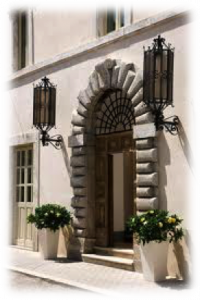For the Information Packet regarding our Easter 2016 Pilgrimage, read below, or click here.
Please call 202-536-4555 or email [email protected] to have us hold a place for you. We expect a quick sellout!
Additional Information
Cost
Daily Schedule
Monday in Holy Week, March 21 – Leave from the US. You have packed lightly, but taken all you need for this unique pilgrimage. Safe flight!
Assisi
Our Holy Week and Easter 2016 Pilgrimage will begin in Assisi, the City of St. Francis. With a population of about 25,000, Assisi is a small medieval town perched on a hill in Umbria in the heart of Italy. Assisi is one of the prettiest and most peaceful cities in the world, and has long been a spiritual center: the temple of Minerva, which two thousand years ago was the centerpiece of Roman Assisi, can still be visited today. We will spend 3 days and 2 nights at the St Anthony Guesthouse, which has been run by our friend, Sister Sue, for over 10 years. She and the other Sisters are waiting to greet you and welcome you to their home in Assisi.
Tuesday in Holy Week, March 22 – Welcome to Italy! You arrive at Fiumicino airport, about 10 miles outside of Rome to the west, near the Mediterranean Sea. You may have seen the sea as your plane circled to land. Robert and Deborah will meet you at the gate as you come out with your luggage after going through customs—you will walk right through the “nothing to declare” line—and we may have a quick morning coffee, tea, and brioche, or as the Italians call it, a cornetto. We will then cross to our waiting private motor coach, and head out for that little town in central Italy where St. Francis of Assisi was born.

View from St. Anthony’s Guesthouse
As we drive north and east, you may either sleep after your long trip, or discuss a bit of history. While looking out over Lazio and Umbria, we will give you your first overview of the pilgrimage. After about two hours of driving, we will pull into the walled city of Assisi, and you will be escorted to your guest room at the serene St. Anthony’s Guesthouse, with its beautiful outside gardens. As you stand in the gathering room of the Guesthouse, you will have a panoramic view of the St. Clare’s Basilica and the town of Assisi. The 360-degree views will take your breath away. Our friend Sister Sue will be there to welcome you.
After a quick lunch we will rest for several hours, then attend Mass. The Franciscan friars will be available before Mass for confession. Dinner will be early and delicious at one of our favorite restaurants in Assisi! Our first day will end before dark so we all can go to bed early for a good night’s sleep.
Wednesday in Holy Week, March 23 – Assisi. Attending Mass at the tomb of St. Francis will begin our second day in Italy. It is a short walk downhill through the streets of Assisi to the Basilica of St. Francis. There, we will be greeted by our friends who oversee the Basilica, the Franciscan Friars, who will give us a guided tour after Mass. After our visit to there, our bus will drive us to the Basilica of Our Lady of the Angels, in the valley at the bottom of the hill. Brother Alessandro always welcomes us with his beautiful smile, joined perhaps to a delightful song. His story is amazing and his voice is angelic.
After our visit to the Basilica of Our Lady of the Angels, we will stop to recollect our morning over a wonderful Italian lunch. We will return to St. Anthony’s guesthouse for a rest before our visit to San Damiano, the church connected with Saint Francis’ encounter with Christ. Brother Euan, who is from England, now resides there and will greet us and explain further this story. Our last visit will be to the Basilica of St. Clare before we end our day with a meal at another one of our favorite restaurants, where we will share local wine, wonderful local food and our thoughts about the day.
Holy Thursday, March 24 – Assisi. After a leisurely breakfast, Marcella, our friend who was born and raised in Assisi, will guide us through the historic streets of Assisi, pointing out many of the hidden gems along our stroll; we will enter several important churches along the way, such as the Basilica of St. Clare and San Rufino (St. Rufinus), and come to a better understanding of the time of St. Francis. We will have lunch in the Piazza del Comune, the main piazza in the city center, one of the most beautiful piazzas in Italy. After lunch, we will depart Assisi for Norcia.
Norcia
Over the centuries, “Nursia” has, in the Italian language, become “Norcia.” However, it is still the same city—the heart of Benedictine monasticism. Benedict and his twin sister, Scholastica, were born here in the late 400s, at the time of the collapse of the Roman Empire in the West. So what we have in Norcia is a “link” to that ancient world which perished with Rome’s fall, but which, through the mediation of Benedict and Benedictine monasticism, came down to us through the so- called “Dark Ages” after Rome’s fall, those centuries from 500 to 1000 A.D., where civilization and learning were restricted to the little enclaves of Benedictines monasteries.
However, for the last two centuries, there has been devastation. The monastery that had flourished for a millennium was closed under the secularizing Napoleonic legislation introduced into Italy two centuries ago, in 1810. So, for 200 years, there were no monks here.
It seemed as if the link with the past had been broken. However, all of this changed with Father Cassian Folsom, an American Benedictine, who has been a friend since 1990. Father Cassian went to Cardinal Ratzinger (now Pope Emeritus Benedict) in the 1990s, saying that he sensed a vocation to re-found the Benedictine monastery in Norcia, and Cardinal Ratzinger encouraged him to do so. And so he came to Norcia with two companions, and by themselves, with no help, they brought the ancient monastery back to life. What they were doing raised eyebrows, but bit by bit, other young men came to join them.
Today, there are 18 monks in Norcia, and Father Cassian is gaining a worldwide reputation for his humble zeal in restoring the faith. We will have a chance to talk to him directly, and, if desired, to go to confession to him or to another one of the priests. Then we will attend the Mass celebrated by the monks in their chapel. You may also join them as they chant their prayers each morning and evening in the crypt church.
Holy Thursday, March 24 – Norcia. The Palazzo Seneca will be our home for the next 2 nights and is only 50 yards from the main piazza where the Benedictines celebrate Mass. The palace that houses Palazzo Seneca was originally built in the 16th century and was completely renovated a few years ago. A spa and cooking school are just two of the impressive amenities. Quiet time in the Palazzo can be spent sitting in the beautiful library, or in the garden room for a cup of afternoon tea or cappuccino. The family-owned hotel is sophisticated, simple and luxurious, which is why it was awarded the prestigious Relais & Châteaux award—an exclusive honor
Palazzo Seneca. After a rest, we will make our first visit to the Benedictine monastery of Norcia, built precisely over the place where Benedict and Scholastica were born.
In the early evening of Holy Thursday, we will participate in the Liturgy of The Lord’s Supper. Afterwards, we will have dinner at a restaurant, next to our hotel, with a huge stone fireplace and oven at one end of the dining room (photo above). In mid- spring, when we come here, this provides needed warmth, but you will appreciate the fireplace for its ambiance more than for its warmth. Some of the monks will join us for dinner, and we will begin to learn their story—one of the most remarkable in the Church today. These dinners are times for thoughtful conversation in the heart of Italy as we enter yet deeper into the mystery of Christ’s Death and Resurrection.
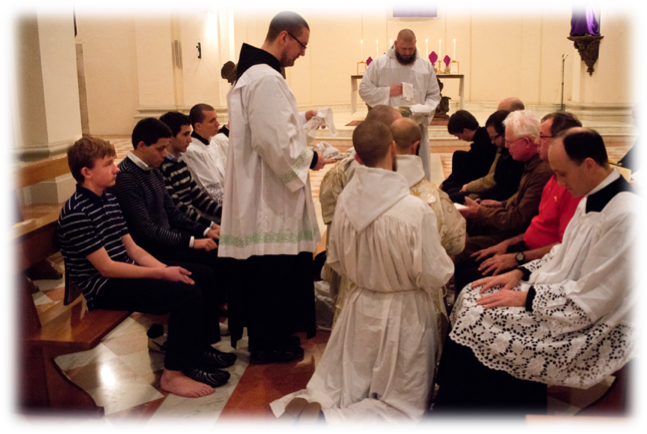
Holy Thursday – Washing of the Feet with Father Cassian in the Basilica of St. Benedict, Norcia, Italy
Ancient Wisdom Continues in the Sibillini Mountains
The region around Norcia, in central Italy, is filled with rugged mountains and steep valleys. This makes it a perfect area for hiking and breathing the fresh clean air, far from the crowded cities of Italy and the rest of Europe.
After Christian monasticism began to flourish in the desert areas of Egypt, and then of Syria—in the Christian east—during the 300s and especially during the 400s, gradually some monks began to travel westward to Italy and southern France. In the time of St. Augustine (354-430 A.D.), in the decades just before the birth of St. Benedict in 480 A.D., the valleys around Norcia began to be populated by dozens of these monks. Many were hermits, living a solitary life. Others lived in more or less interconnected small groups, which provided an early model for what would become the communal life of St. Benedict’s monks.
Over the centuries, this eastern monastic experience was transferred to central Itay, and influenced first Benedict himself, and then many others.
Today, strikingly, there is a return to Norcia of Benedictine monasticism in the community headed by Father Cassian Folsom, whom we will visit.
But what is little known is that there is also a new flourishing of hermitic monastic life in the region outside of Norcia, in the valleys and on the mountain slopes of the Sibillini mountains. No one knows exactly how many hermits are living there. All that is known is that these hills and valleys have become, once again, a “vineyard of the Lord,” where many seek to grow closer to God through a disciplined life of prayer and reflection. These hermits are not entirely isolated; they sometimes receive guests. And on our pilgrimage, we will have the opportunity to go into the mountains and meet with one or more of the hermits, listen to their spiritual reflections and learn from them.
We have made an appointment with Sister Maria, who lives near Amendola, in a small hermitage on the side of a mountain which is sometimes inaccessible due to winter snowstorms. She will receive our pilgrims and spend time with us. This extraordinary experience with a woman hermit in the Sibillini Mountains will be one of the highlights of our pilgrimage.
Good Friday, March 25 – Norcia/Amandola. We wake to the most solemn day in the Church year, Good Friday. Although some may choose to fast, there will be a delicious breakfast spread in the quaint garden room filled with the morning light. Fresh fruits, local cheeses, eggs cooked to order and a variety of breads, all food is local and fresh.
It is fitting to visit a hermit on this solemn day – someone who lives alone with the Alone each and every day of the year. A 90 minute drive around the Sibillini Mountain National Park will bring us to Amandola, where we will visit a hermit and seek her wisdom.
We will return to Norcia for a bowl of soup before preparing to have Good Friday liturgy with the monks. The monks chant the liturgy in Latin. It is a solemn moment, yet truly an “extraordinary” experience, but in an “ordinary” way, for this is how the monks worship every day. We will provide Latin- English missals so you will be able to follow everything without confusion. Later, we will have our evening meal before the warm glow of the brick fireplace to reflect and share our impressions of the day.
A Medieval Tradition Continues…
The Good Friday Procession of Norcia, Italy— On Good Friday, at 9:00 p.m., we will begin our short walk to one of the main piazzas inside the ancient, walled city of Norcia.
Once we have arrived at the piazza, we will take our places alongside the many Italians who have also journeyed here year after year, from all over the Italian “boot,” to witness and participate in, and, in a way, relive, the poignant events of the First Good Friday. Everyone is here for the living Stations of the Cross, all the local people of Norcia—many of whom are actors with roles in the sacred performance—as well as devout visitors, pilgrims, religious, and clergy.
The crowd grows with the presence of the horses that will carry the Roman soldiers, as they trot into the procession. For many, what begins is the transporting of Jerusalem to Norcia, and it borders on the extraordinary.
The sacred drama begins with the conferring of a priestly blessing. We see — but more than that, we experience — the touching scenes of key Stations portraying Jesus Christ making His way to Calvary.
At the same time, we, too, make our walk outside the walls of the city. As we stop at each of the Stations depicted, we find ourselves perhaps stepping back in time to that Night of Nights of two millennia ago.
From His arrest and appearance before Pontius Pilate, to meeting His sorrowful Mother, to encountering the weeping women of Jerusalem, and culminating at the hill of the Cross, we pilgrims witness the Passion of Christ as few Christians can. This moving experience, one and one-half hours long, is the memory of a lifetime.
Holy Saturday, March 26 – morning: Norcia.
We wake to our last meal in Norcia followed by a reflection by Father Cassian. Father Cassian has been battling with a debilitating form of blood cancer, but his suffering has only deepened his spiritual vision, and some are beginning to say, in and around Norcia, that he is a living saint. So we feel very privileged to spend this time with our old friend who is doing so much for the Church, and who always has profound insights to impart to our pilgrims.
After we spend time with Father Cassian, we depart, at last, for Rome, and for the Vatican City State, the heart of the Church, where we will attend the Easter Vigil Mass celebrated by Pope Francis.
Rome and Vatican City
This is a unique time in Rome, as Pope Francis continues to define his pontificate, and Pope Emeritus Benedict continues to reside in Vatican City in a small convent inside the Vatican gardens, not far from the Domus Santa Marta — the residence of Pope Francis. The Vatican is very busy during Holy Week, culminating with many pilgrims filling St. Peter’s piazza for Easter Sunday Mass and Pope Francis’ Urbi et Orbi blessing. In these moments, we will feel the universality of the Church as we come together for these Easter Celebrations at St. Peter’s Basilica, during these days of the “two Popes,” Benedict and Francis, both so very different and yet each so filled with the love of Christ and of His Church.
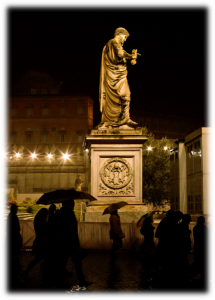 Holy Saturday, March 26 – afternoon: Rome. We will stop for a light lunch on our drive into the Eternal City. We will experience an Italian Autogrill known for good Italian snacks and meals. This lunch will be one of the two meals that will be on your own. After lunch, we arrive to our hotel for the next 5 nights, Hotel Michelangelo. We plan to have enough time for a brief rest before dinner. After dinner we depart for St. Peter’s Basilica for the Easter Vigil Mass with Pope Francis.
Holy Saturday, March 26 – afternoon: Rome. We will stop for a light lunch on our drive into the Eternal City. We will experience an Italian Autogrill known for good Italian snacks and meals. This lunch will be one of the two meals that will be on your own. After lunch, we arrive to our hotel for the next 5 nights, Hotel Michelangelo. We plan to have enough time for a brief rest before dinner. After dinner we depart for St. Peter’s Basilica for the Easter Vigil Mass with Pope Francis.
Easter Sunday, March 27 – Vatican City. We begin this joyous day with breakfast. Easter Sunday Mass in St. Peter’s Piazza is a jubilant celebration. The piazza is filled with flowers, and song fills the air from St. Peter’s choir. Pope Francis will deliver his Urbi et Orbi blessing immediately following the Easter Sunday Liturgy.
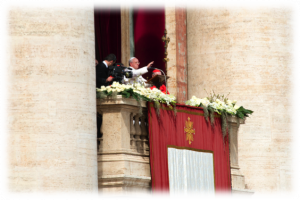 Easter Sunday lunch will be at one of our favorite restaurants near the Vatican. Our afternoon will be quiet, allowing time for pilgrims to reflect, rest or explore Rome.
Easter Sunday lunch will be at one of our favorite restaurants near the Vatican. Our afternoon will be quiet, allowing time for pilgrims to reflect, rest or explore Rome.
In the late afternoon/early evening, we will taxi to the Spanish Steps, where we will begin our slow walk to the Trevi Fountain, the Pantheon, and the Piazza Navona (photo below). We will also visit the Basilica of Sant’Andrea delle Frate, where Our Lady appeared to Alphonse Ratisbonne, an avowed anti-Catholic Jew, in 1842, effecting his miraculous conversion. This special church is also where St. Maximillian Kolbe offered his first Mass. As always, we will be pointing out the historical and religious significance of the important places we will encounter along our afternoon stroll. On the walk back to the Vatican area, we will stop at another fine restaurant for dinner before we return to our hotel, The Michelangelo.
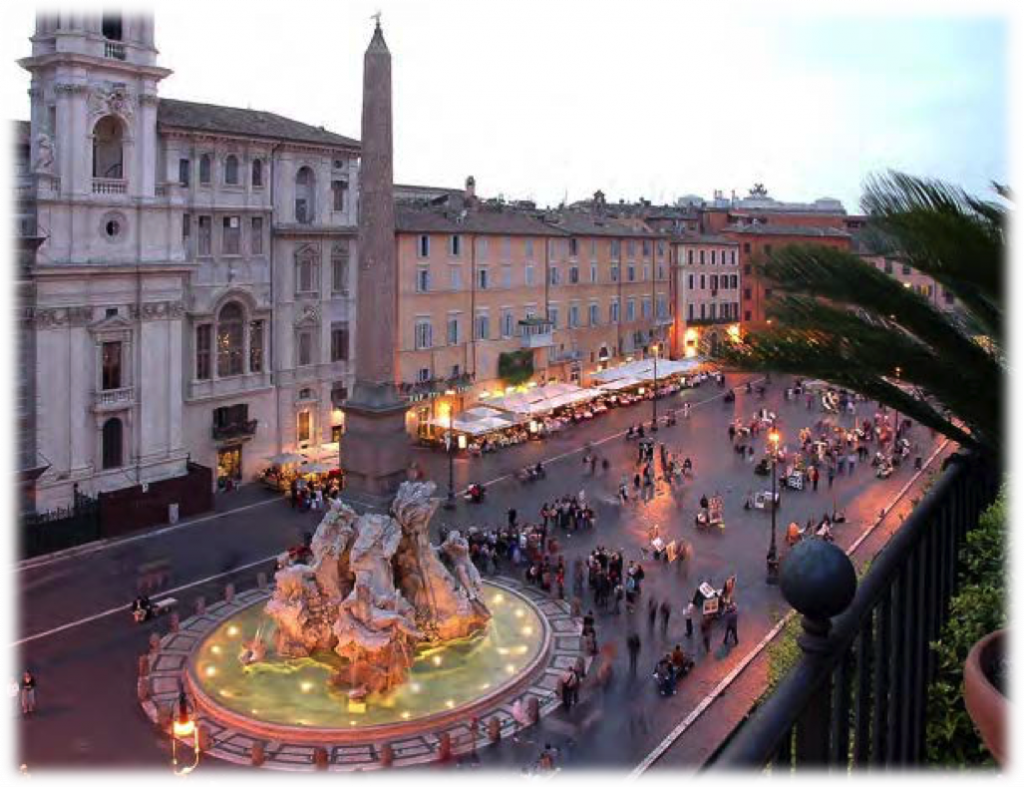
Piazza Navona
Eucharistic Miracle of Lanciano
Lanciano, which translates into “the lance,” is named after the lance of Longinus, the Roman soldier, who thrust his spear into Our Lord’s side. Lanciano bears this name because it is the birthplace of St. Longinus. Around the year 700, a Basilian monk offered mass in Lanciano’s small church of St. Legontian. The monk, who had doubts about transubstantiation, wondered if the bread and wine really became the Body and Blood of Jesus Christ.
At the words of Consecration, the doubting priest witnessed the bread transform into living flesh and the wine transform into five actual drops of blood, which then congealed. The five drops, of course, represent the number of wounds Christ suffered. on the cross: one in each hand and foot from the nails, and the wound from the spear
Easter Monday, March 28 – Rome/ Lanciano / Manopello. Today is la Pasquetta (“little Easter”) in Italy. It is a national Italian holiday in order to continue the joyous Easter celebration. We, too, will continue our celebration by traveling to two very important shrines which house the most important miracles in Italy – the Eucharistic Miracle of Lanciano and the Shrine of the Holy Face.
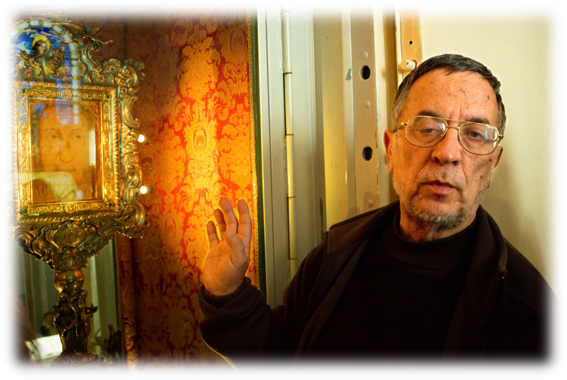
Father Cucinelli, friar at the Shrine of the Holy Face
We will be up early to travel about 2 1⁄2 hours, across Italy to the Adriatic Sea, to the town of Lanciano in the rugged Abbruzzo region. Once we arrive in Lanciano, we will enter the church that houses the Eucharistic Miracle (photo above) to behold the wonders of the Body and Blood of Jesus Christ made visible. After venerating the miraculous substance, we will listen to the Franciscan Friars to learn more about the Eucharistic miracle.
We then will turn back towards Rome, heading to the little town of Manoppello, Italy (population 157 — yes, it’s tiny!) still in the Abbruzzo region. Our drive is short — only 40 minutes. There, we will visit the Shrine of the Holy Face — the shrine which contains a mysterious cloth (photo right) bearing the image of a man with wounds on his face, an image some believe is the actual face of Christ, formed at the moment of his Resurrection and celebrate Mass.
Pope Emeritus Benedict visited this Shrine in 2006 to venerate the Holy Face of Manoppello. Before our visit to the shrine, we will first have lunch at the same restaurant Pope Benedict dined at when he visited Manoppello — a family- owned restaurant where Nonna, Grandma, cooks with the fresh ingredients from the region. A real Italian experience! After a few hours in Manoppello, we depart for Rome and enjoy another snack or meal in an Italian Autogrill. This will be the second of two meals on your own.
Easter Tuesday, March 29th – Vatican City. We will wake to have our breakfast, then we will depart for the three other patriarchal basilicas in Rome, St. Mary Major, St. John Lateran, and St. Paul’s Outside the Walls. St. Peter’s Basilica is the fourth patriarchal basilica. Each of these churches is a glorious monument to the Faith and contains treasures of art and faith that can take one’s breath away. We will have a private Mass at one of these Basilicas.
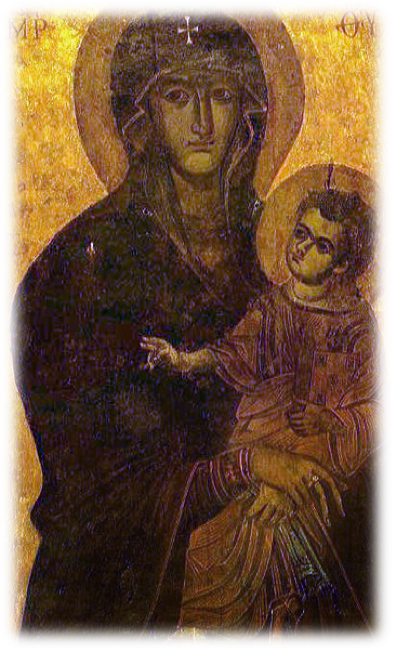 In St. Mary Major, there is a painting of Mary (photo left), which is believed to be painted by St. Luke himself, making it the oldest painting of Mary in the world. It is called the Salus Populi Romani (English: Protectress of the Roman People — Protectress is a translation of the Latin “salus” which means “salvation” or “health.”) It has historically been the most important Marian icon in Rome, and was crowned by Pope Pius XII in 1954. Pope Emeritus Benedict XVI venerated the Salus Populi Romani on different occasions, and asked Mary on each occasion to “pray for us.” One of the first acts after his election was Pope Francis’ prayer before Salus Populi Romani. In May of 2012, the month dedicated to Our Lady and the Holy Rosary, Pope Francis also prayed his first public Rosary before this ancient and venerable image. And, he has continued to honor this important Basilica, visiting it over six times since his election.
In St. Mary Major, there is a painting of Mary (photo left), which is believed to be painted by St. Luke himself, making it the oldest painting of Mary in the world. It is called the Salus Populi Romani (English: Protectress of the Roman People — Protectress is a translation of the Latin “salus” which means “salvation” or “health.”) It has historically been the most important Marian icon in Rome, and was crowned by Pope Pius XII in 1954. Pope Emeritus Benedict XVI venerated the Salus Populi Romani on different occasions, and asked Mary on each occasion to “pray for us.” One of the first acts after his election was Pope Francis’ prayer before Salus Populi Romani. In May of 2012, the month dedicated to Our Lady and the Holy Rosary, Pope Francis also prayed his first public Rosary before this ancient and venerable image. And, he has continued to honor this important Basilica, visiting it over six times since his election.
The Roman Breviary states: “After the Council of Ephesus (431) in which the Mother of Jesus was acclaimed as Mother of God, Pope Sixtus III erected at Rome on the Esquiline Hill, a basilica dedicated to the honor of the Holy Mother of God. It was afterward called Saint Mary Major and it is the oldest church in the West dedicated to the honor of the Blessed Virgin Mary.”
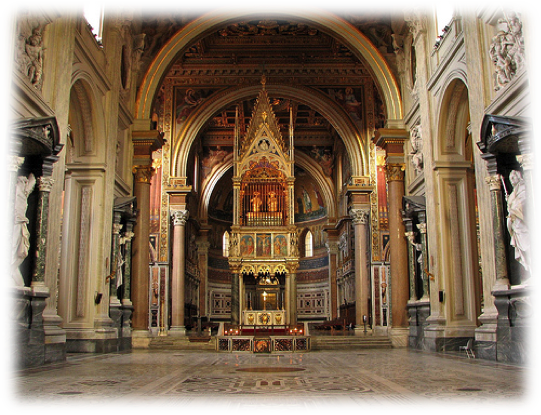 St. John Lateran (photo right) is the oldest and ranks first among the four Papal basilicas of Rome, since it is the cathedra or “seat” of the Bishop of Rome. So, it was the first church built in Rome. For centuries, the Popes lived here. The façade has the inscription Christo Salvatori, “To Christ the Savior,” indicating the church’s dedication to Christ—the cathedrals of all patriarchs are dedicated to Christ himself.
St. John Lateran (photo right) is the oldest and ranks first among the four Papal basilicas of Rome, since it is the cathedra or “seat” of the Bishop of Rome. So, it was the first church built in Rome. For centuries, the Popes lived here. The façade has the inscription Christo Salvatori, “To Christ the Savior,” indicating the church’s dedication to Christ—the cathedrals of all patriarchs are dedicated to Christ himself.
As the cathedral of the Bishop of Rome, it ranks above all other churches, including St. Peter’s, and so, unlike all other Roman Basilicas, it holds the title of Archbasilica. In ancient Rome, it was the baptism church. The Archbasilica was built in the time of Constantine and was consecrated by Pope Sylvester in 324.
St. John Lateran contains several important relics: an ancient baptistry built by Constantine; beneath the High Altar, which can only be used by the Pope, contains a relic said to be part of St. Peter’s communion table; and the Altar of the Holy Sacrament containing a cedar table that is said to be the one used by Christ at the Last Supper.
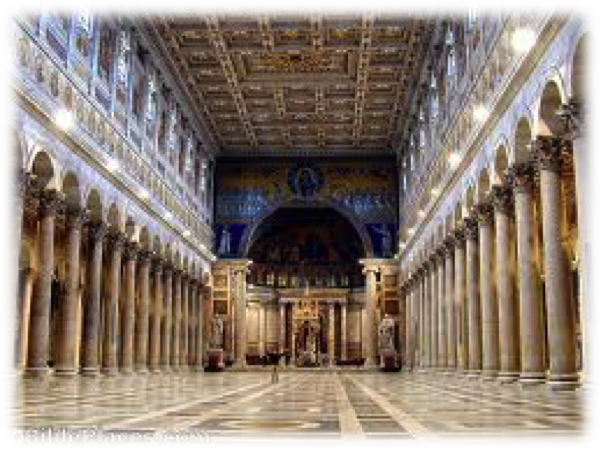 St. Paul’s Outside the Walls (photo left) is dedicated to St. Paul, the Apostle to the Gentiles, who was beheaded in Rome, and contains his tomb. This very impressive church contains the images of all the Popes in little circular portraits.
St. Paul’s Outside the Walls (photo left) is dedicated to St. Paul, the Apostle to the Gentiles, who was beheaded in Rome, and contains his tomb. This very impressive church contains the images of all the Popes in little circular portraits.
Because we only have a few hours to see these magnificent, historic basilicas, we will concentrate on the meaning of each of the buildings, and the life and work of each of the saints to whom these basilicas are dedicated. We will stop along the way for a quick café and light lunch.
We will end our afternoon back at the Hotel Michelangelo and you will have some free time to shop, rest or to visit St. Peter’s Basilica again on your own before dinner.
Wednesday, March 30 – Vatican City. Our last full day together begins with breakfast at the Hotel Michelangelo. We then head to the Papal Audience, which begins at 10:30 a.m.
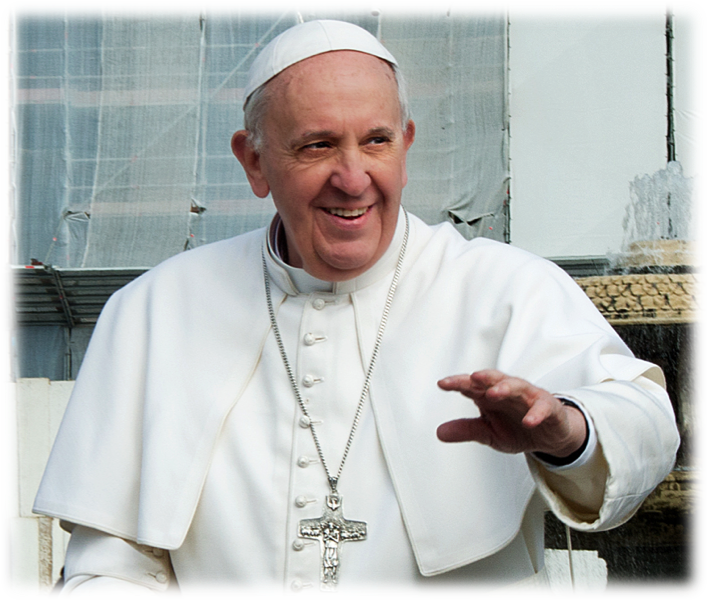 During the audience, Pope Francis will share a small teaching and reading in Italian, but it will be translated into English, French, German, Spanish, Polish, Portuguese, and sometimes other languages, depending on the groups visiting.
During the audience, Pope Francis will share a small teaching and reading in Italian, but it will be translated into English, French, German, Spanish, Polish, Portuguese, and sometimes other languages, depending on the groups visiting.
The Pope will follow with a greeting to all gathered in St. Peter’s piazza. At the end of the Audience, the Pope will lead us in the Our Father in Latin. This prayer will be printed on the back of the Papal Audience ticket. After the Our Father, Pope Francis will impart his Apostolic Blessing upon the crowd, which also extends to our loved ones at home. He will bless any item that you may have purchased along our journey together.
After the Papal Audience, we will have lunch together near the Vatican. A visit to one of our cardinal friends in his apartment will follow lunch. These encounters remain with our pilgrims for many years as they are intimate and personal. We will hear stories about the universal Church from a very wise man who has lived many decades in Rome at the service of the popes.
Later that afternoon, following our meeting and lunch, we will have a brief rest or free time. Our farewell dinner, hosted by Dr. Robert Moynihan and Deborah Tomlinson, will be a celebratory feast and special friends and guests of Inside the Vatican magazine will be joining us.
Thursday, March 31 – Farewell. After an early morning Mass, breakfast, and farewell, your driver will escort you back to the airport for your return home. Farewell to all our fellow pilgrims, our friends, until we meet again…
Not mentioned in this sketch of our itinerary are perhaps the two most important points…
1) During our days in Rome, we will have the chance to meet with a number of Vatican monsignors, and perhaps even an archbishop or cardinal, who will listen and respond to pilgrims’ questions and concerns about the Church today, about issues of concern to Church members, and about working alongside Pope Emeritus Benedict and Pope Francis. These meetings change from pilgrimage to pilgrimage, but they are always remembered by pilgrims as special moments to be close to the Pope as he leads the Church in this difficult period of history. Many of these are unexpected encounters as we walk near the Vatican.
2) We prefer to schedule Mass in the morning, but there is a possibility that Mass times can fluctuate due to circumstances and our daily events. Each day we will have the opportunity to attend Mass. The daily Mass schedule for the Rome portion of our pilgrimage will be finalized closer to the time of our departure.
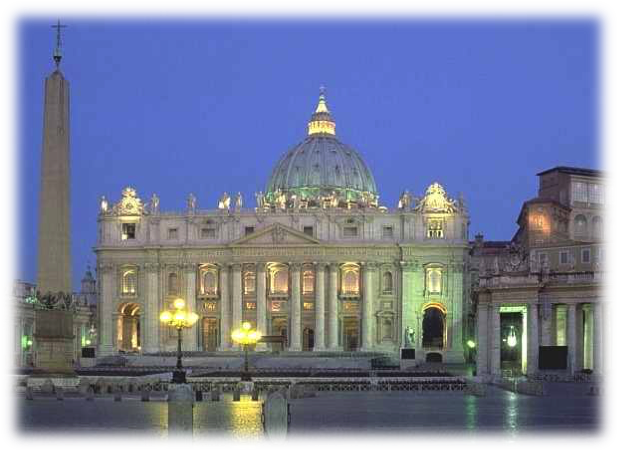
We will make every effort to adhere to the printed program and itinerary. On rare occasions it may be necessary to adjust arrangements due to unforeseen circumstances beyond our control (including such circumstances as the weather, airline schedule change, hotel requisitions, political disturbances, or transportation mechanical problems). Should such adjustment be necessary, substitution will be made to the best of our abilities.
Join Inside the Vatican for this once-in-a-lifetime pilgrimage!
To view the complete registration packet with special letters from Dr. Robert Moynihan and Deborah Tomlinson click here.
To register for this pilgrimage, click here for the registration documents only. Please mail completed forms and deposit to:
Inside the Vatican
14 West Main St.
Front Royal, VA 22630
For more information or to reserve your spot, contact our US Office at 1-202-536-4555 or email us at [email protected]
We have many pilgrimages in 2016 2016 Pilgrimages








